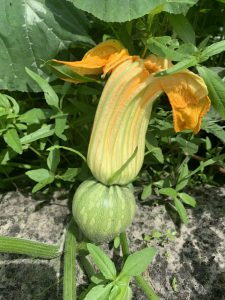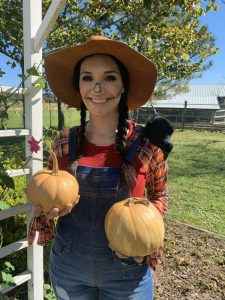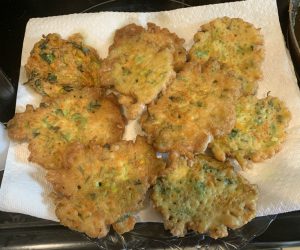The summer heat is coming to a close and fall is certainly in the air. ‘Tis the season for harvesting pumpkins – whether we use them for decorations at Halloween or cooking our Thanksgiving meal – it is definitely the time of year we get to enjoy pumpkins.  Some folks may not know that we have tropical pumpkins that are native to Florida. These are different from the typical Jack-O-Lantern pumpkins used for carving and candle lighting. Native pumpkins, such as ‘Seminole’, are well-adapted to tropical environments and are comfortable growing in low fertility soils. This characteristic is very similar to sweet potatoes, one of my personal favorites, as they grow best in tropical climates and require very little nutrition relative to other specialty crops grown in Florida. Along with other types of squash, native pumpkins belong to the Cucurbita or gourd family whereas sweet potatoes belong to the Convolvulus or morning glory family.
Some folks may not know that we have tropical pumpkins that are native to Florida. These are different from the typical Jack-O-Lantern pumpkins used for carving and candle lighting. Native pumpkins, such as ‘Seminole’, are well-adapted to tropical environments and are comfortable growing in low fertility soils. This characteristic is very similar to sweet potatoes, one of my personal favorites, as they grow best in tropical climates and require very little nutrition relative to other specialty crops grown in Florida. Along with other types of squash, native pumpkins belong to the Cucurbita or gourd family whereas sweet potatoes belong to the Convolvulus or morning glory family.  Native pumpkins are very popular for making pies and are a common part of the Spanish-speaking community and Caribbean diet.
Native pumpkins are very popular for making pies and are a common part of the Spanish-speaking community and Caribbean diet.
Summer is the right time to plant pumpkins since they only have to compete with cover crops when grown in the Tri-County Agricultural Area of St. Johns, Flagler and Putnam. Prissy Fletcher, Agriculture Agent with St. Johns County, received grant funds and led the effort to plant a half-acre pumpkin patch at the UF/IFAS Hastings Agriculture Extension Center on July 15, 2020. She planted six different varieties – three edible types including ‘Seminole’, ‘La Estralla’ Calabaza, and ‘Jarrahdale’ and three mainly ornamental types  including ‘Jill-be-Little’, ‘Baby Pam’ and ‘Marina di Chioggia’. A short youtube video found here – https://www.youtube.com/watch?v=gvC6PGotViw&t shows each of the varieties up close.
including ‘Jill-be-Little’, ‘Baby Pam’ and ‘Marina di Chioggia’. A short youtube video found here – https://www.youtube.com/watch?v=gvC6PGotViw&t shows each of the varieties up close.
Native tropical pumpkins have a real advantage over the prevalent pests that are accustomed to Florida’s heat, and they fare much better than the ‘Jack-O-Lantern’. To minimize pest influence in the pumpkin patch, they were planted on metallic-colored plastic with a reflective tint that deters the pests. But the scarecrows better keep their sunglasses on when hanging around the reflective plastic, or else their eyes may fall out. Speaking of scarecrows, our spirited 4-H Agent (Alisha Hutchinson) has posed with her pumpkins for the Flagler County BOCC First Annual Halloween Costume Contest.
Although we cannot sell our pumpkin beauties, they are certainly not going to waste. The slightly sweet inner flesh of a ‘Seminole’ pumpkin tastes very similar to butternut squash. It is less fibrous and more than the pulp of a ‘Jack-O-Lantern’. To fully embrace our pumpkin experience, Prissy has organized a Pumpkin Pie Contest for the UF/IFAS faculty and staff housed in the TCAA. We have 14 bakers from the TCAA offices that will choose one of the three edible varieties and harvest their own fresh pulp. The  judges consist of growers from all three Counties and they will have their fill of pumpkin pie on November 11 at Molasses Junction. Native pumpkins also offer a salty snack if you roast the seeds or even harvest the yellow flowers that are not designed to fruit. Pumpkins (and all other squash) produce both male and female flowers, but only the female flowers produce the fruit. So is the flower is in full bloom and there is no sign of fruit, you can harvest the flowers and fry up some delicious pumpkin flower fritters. This is certainly a versatile crop that has so much untapped potential here in Florida.
judges consist of growers from all three Counties and they will have their fill of pumpkin pie on November 11 at Molasses Junction. Native pumpkins also offer a salty snack if you roast the seeds or even harvest the yellow flowers that are not designed to fruit. Pumpkins (and all other squash) produce both male and female flowers, but only the female flowers produce the fruit. So is the flower is in full bloom and there is no sign of fruit, you can harvest the flowers and fry up some delicious pumpkin flower fritters. This is certainly a versatile crop that has so much untapped potential here in Florida.
 0
0
